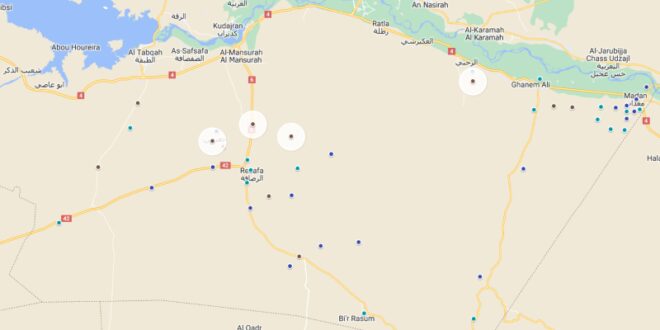ISIS carried out at least 16 confirmed attacks in September in the Aleppo, Homs, Hama, Raqqa, and Deir Ez Zor governorates. These attacks killed at least 32 pro-Assad regime soldiers and one civilian and wounded at least 21 others. There were also five high quality* attacks carried out during the month. The frequency of ISIS attacks in September was roughly consistent with the number in August. However, unlike in August, September attacks were much deadlier and overwhelmingly focused on security forces, with only one documented attack against civilians.
September’s activity generally continued August’s trend of more frequent, deadly, and sophisticated attacks, as opposed to July, when ISIS activity dropped to near record low levels. ISIS cells continue to operate aggressively in southern Raqqa while also reviving activity in the Kawm and Ithriya regions of Homs and Hama, respectively. ISIS appeared to have largely abandoned both of these regions in recent months following regime operations. Throughout September, the Russian Air Force continued its high-tempo aerial campaign against suspected ISIS positions in the desert. For example, on September 30, Russian-commanded units of the Syrian 25th Division again conducted wide-ranging anti-ISIS operations across eastern Homs and western Deir Ez Zor. These units were accompanied by members of the Russian Bear Brigade, a Private military company (PMC) under the command of the Russian Ministry of Defense, formed in March 2023 for operations in Ukraine and Africa.
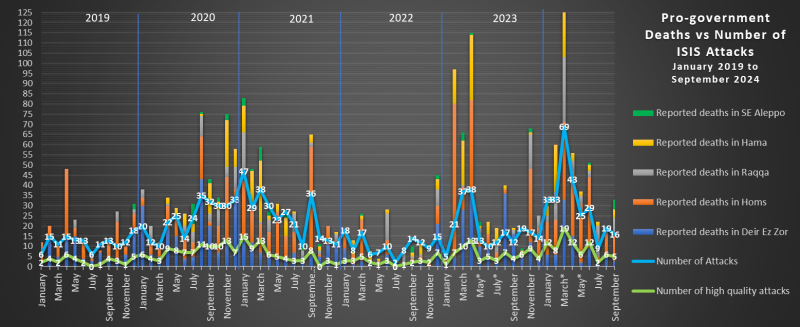
*Indicates attacks in Damascus City claimed by ISIS. Additional IED attacks occurred in Homs City in June 2023 and in Damascus in March 2024 and May 2024 that went unclaimed but were suspected to be conducted by ISIS.
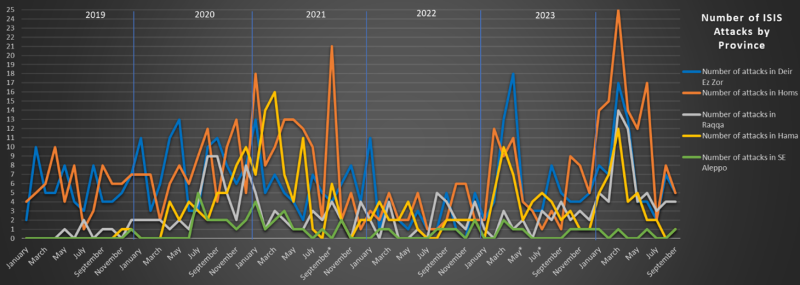
Confirmed ISIS attacks remained steady in Raqqa (4), increased slightly Aleppo (1) and Hama (1), and decreased in Homs (5) and Deir Ez Zor (4).
Deir Ez Zor
ISIS expanded its low-level insurgency within the urban belt of Deir Ez Zor in January, when it conducted three assassinations of local security forces. Sleeper cells continued this trend through April, conducting nine urban assassinations inside Mayadin City. In May, regime security forces captured a small four-man ISIS cell inside Mayadin. According to local journalist Zain al-Abidin, three of the detained men were serving in the pro-regime National Defense Forces (NDF) and their leader had entered Mayadin from northeast Syria during the regime’s 2022 reconciliation initiative – a security risk this author had highlighted at the time. Between June and August, ISIS assailants conducted an IED and three small arms attacks across Deir Ez Zor City, Shamitiyah, and Mayadeen City. There were no documented urban attacks in Deir Ez Zor in September, however on September 28, video taken from across the Euphrates River appears to show Russian airstrikes in the area around Shamitiyah, possibly indicating an attempted ISIS attack.
On September 4, a soldier from the 10th Border Guards Regiment was killed in the Boukamal countryside, and a militia fighter was killed in an unspecified location in the governorate. On September 7, ISIS militants attacked a 17th Division position east of Shoula, though no casualties were reported. On September 27, two 5th Corps soldiers were wounded in an ISIS attack on their position northwest of Shoula. On September 30, a vehicle carrying members of the Iranian-backed Liwa Imam al-Baqir militia was hit by a mine or improvised explosive device (IED) outside Sahiliyah, killing one and wounding two. A similar attack occurred in this area on August 30.
In Raqqa, ISIS activity in May dropped back down to more typical levels following two months of heightened activity. Since then, the group has maintained a low-level but robust insurgency in the desert between Resafa and Jabal Bishri. This trend continued in July and August. In September, ISIS attacks in southern Raqqa became deadlier and also moved eastward, occurring more frequently in the countryside south of Tabqa.
On September 3, ISIS militants attacked a small convoy of oil trucks traveling the Tabqa-Ithriya road, causing some material damage. On September 4, six Republican Guard soldiers were killed in an attack on a security checkpoint near Ja’adin, northwest of Resafa. The next day, ISIS fighters attacked a group of shepherds near Sabkha, killing one man and dozens of sheep. On September 8, two soldiers were killed in fighting northwest of Resafa. On September 18, militants conducted another attack on oil trucks traveling the Resafa road, damaging two of the tankers.
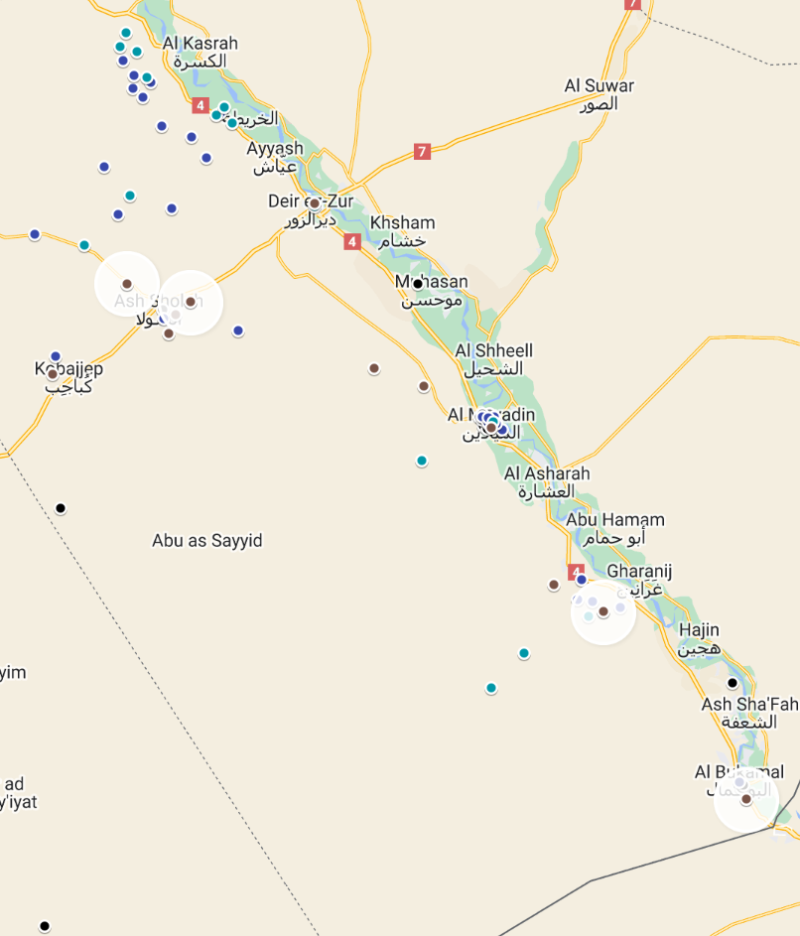

Map of locatable ISIS attacks (highlighted) in Deir Ez Zor (top) and Raqqa (bottom) in September 2024 alongside all other attacks in 2024. Note that one attack in Deir Ez Zor could not be mapped.
Homs
ISIS activity in eastern Homs decreased in December 2023, but remained focused around the Doubayat Oil Field, which the group had temporarily captured in November. January 2024 likewise saw most ISIS activity concentrated in this area, though the group also expanded operations west into the desert just south of Palmyra and Arak. In February, ISIS largely abandoned the southern Palmyra front, likely because of pro-regime ground and air operations, and shifted its focus to the Taybeh sector north of Sukhnah and the Jubb Jarah mountains north of Palmyra. This focus continued into March, with activity remaining concentrated in the Sukhnah-Taybeh-Kawm axis in both April and May. However, security forces continued to largely stand their ground and June saw ISIS once again shift its attacks to the Jubb Jarah and southern Wadi Doubayat-Palmyra region, seemingly abandoning the Taybeh-Kawm front. The deployment of significant numbers of Russian-backed 25th Division fighters in early June and those subsequent battles appear to have resulted in ISIS largely abandoning all eastern Homs fronts in July. In August, ISIS renewed its violent activity in eastern Homs, but largely avoided the core Palmyra-Sukhnah region, likely now too heavily fortified for the group to risk attacking.
In September, ISIS activity returned to the Taybeh region for the first time since June. On September 6, ISIS militants attacked a regime barracks west of Taybeh, wounding four soldiers. On September 7, ISIS conducted a large attack on a regime position outside the Tuwaynan Oil Fields. According to ISIS’s official claim of the attack, eight soldiers were killed, three trucks were destroyed, arms and supplies were seized. Regime social media also reported on the attack, announcing the death of an oil engineer working in the field. On September 21, skirmishes west of Taybeh left one Liwa al-Quds fighter killed and six injured. The next day, regime pages claimed a soldier was killed somewhere in the Palmyra countryside. On September 30, two high ranking officers – a lieutenant colonel and a major – were killed and six others injured by a mine or an improvised explosive device (IED) while driving in the Jubb Hamad region west of Palmyra. The officers were from the 11th Division and were likely on their way to participate in the new anti-ISIS operation in eastern Homs.

Map of locatable ISIS attacks in Homs (highlighted) in September 2024 alongside all other attacks in 2024.
Hama and Aleppo
Significant ISIS activity returned to east Hama in January, when the group conducted five attacks, three being high quality. Likewise, ISIS conducted three high quality attacks in eastern Hama in February. This was the first time eastern Hama had witnessed back-to-back months of three or more high quality attacks since spring 2021. In March, there were five high quality and 12 total attacks, almost all against security forces. However, activity fell significantly in April and May, and June had only two documented attacks. July’s activity was likewise limited and in August, no attacks occurred. September witnessed the slight return of ISIS activity, with one documented attack occurring on September 4, when ISIS targeted two positions in the Ithriyah region and killed four soldiers.
Likewise, there was one attack in southern Aleppo in September. On September 14, ISIS fighters killed five members of the pro-regime “Popular Front for the Liberation of Iskenderun District” militia, including the commander of the Safira region center. The attack occurred on the Khanasir-Ithriyah road.
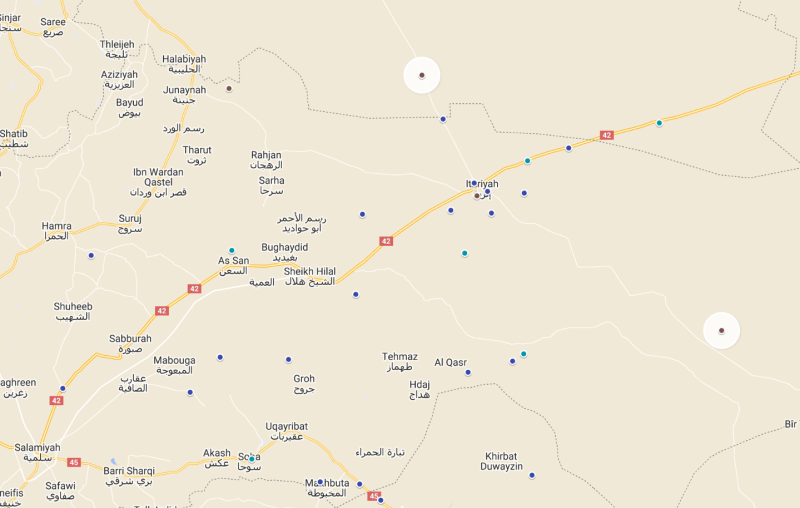
Map of locatable ISIS attacks in Hama and Aleppo (highlighted) in September 2024 alongside all other attacks in 2024.
Looking Ahead
July marked the end of what can be categorized as ISIS’s first sustained Badia campaign since 2020. Beginning with a localized but significant escalation in October 2023 and culminating in a sustained region-wide series of campaigns throughout much of 2024, ISIS showed a renewed energy and strength after years of concentrated regime operations. Still, the regime and its Russian and Iranian allies were able to effectively secure all the critical sites across the region, preventing ISIS from making any permanent gains. Key to this success was the deployment of core regime units that had never before participated in the counter-insurgency campaign.
However, the much-reduced ISIS activity in July did not last long. While August and September were by no means record-setting months, ISIS has shown clear signs of a rapid and sustained partial regeneration in the Badia. The group continues to demonstrate a level of resiliency not seen since 2020. As in August, violent activity in September consisted of a small number of localized attacks – again suggesting the possibility that just a few active cells are responsible for much of the ongoing violence.
Notably, Coalition forces conducted an extremely rare airstrike against ISIS in central Syria in September – the first since October 2020. On September 16, Coalition aircraft struck an “ISIS training camp” somewhere in the Badia, reportedly killing 28 militants and “at least four senior leaders.” It remains to be seen what long term impact this strike will have, but at the very least, it inflicted a degree of casualties rarely, if ever, experienced by Badia cells.
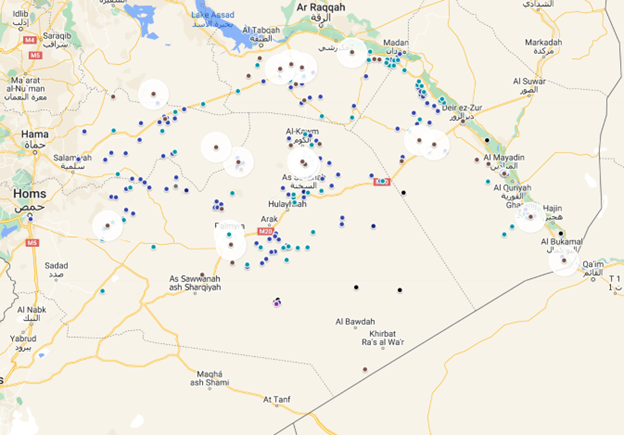
Map of locatable ISIS attacks (highlighted) in September 2024 alongside all other attacks in 2024. Not mapped is one attack which occurred somewhere in the Deir Ez Zor countryside.
*High quality attacks are defined as attacks behind frontlines, attacks that result in seized positions, target regime officers, or involve coordinated attacks on multiple positions, “flying checkpoints” (temporary roadblocks ISIS fighters establish in order to stop and extort or ambush a few cars), ambushes on military convoys, or attacks on checkpoints that kill at least three soldiers or lead to POWs.
 Eurasia Press & News
Eurasia Press & News
